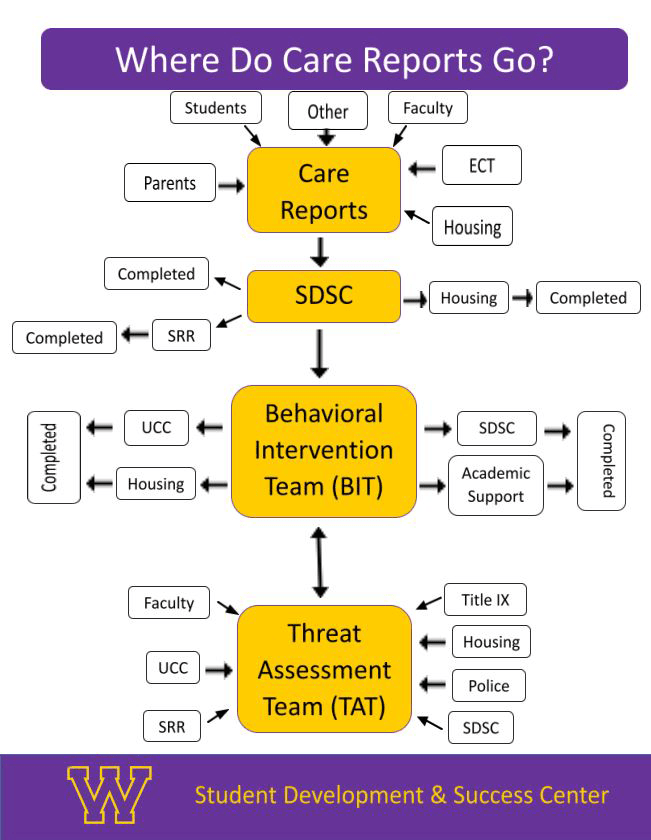
Campus Violence Prevention and Intervention
Committed to promoting a safe and secure community
Intervention Teams
WIU’s Emergency Consultation Team (ECT) is designed to provide WIU and the Macomb community with immediate access to a team member after normal business hours and on weekends. This team member will assess the situation, offer advice and counsel, and record consistent with University policy and procedures. Consultation team members will, as necessary, notify the Vice President for Student Success and act as a liaison between agencies working with issues related to WIU students.
A smaller, core group of the Emergency Consultation Team makes up the Behavioral intervention Team (BIT). The BIT team meets weekly to promote student success and campus safety by facilitating the identification and support of individuals who demonstrate behaviors that may be early warning signs of possible troubled, disruptive or violent behavior. The team collaborates, collects information, identifies risks and intervenes when appropriate to protect students from harming themselves or others. The Behavioral Intervention Team uses a proactive approach that balances the needs of the student who may be in crisis and the overall safety of the campus community.
ECT and BIT Goals
- To provide early intervention for individuals in crisis
- To assist individuals in mitigating sources of distress and get them back on a path towards success
- To serve as a centralized resource for collecting and evaluating information
- To promote and support campus safety
- To educate the campus community about identifying concerning behaviors and the role of intervention teams
- To foster a culture of reporting
- To balance individual privacy with community safety
BIT Members
- Student Development and Success Center (SDSC)
- Retention Initiatives
- Student Life
- Student Rights and Responsibilities
- Beu Health Center
- University Counseling Center
- Provost Office
Threat Assessment Team (TAT)
The Threat Assessment Team (TAT) shares and evaluates available information to determine if an individual poses, or may reasonably pose, a threat of violence to self, others, or the Western Illinois University community. The team responds to behaviors exhibited by students, employees, visitors, and non-affiliated persons with the intent to mitigate risks and prevent violence. The TAT develops an appropriate plan of action, including resources and intervention strategies to address the violence, threats, and/or disruptive behavior.
TAT Goals
- To promote and support campus safety
- To assist individuals in mitigating sources of distress and get them back on a path towards success
- To educate the campus community about identifying concerning behaviors and the role of BIT and TAT
- To foster a culture of reporting
- To serve as a centralized resource for collecting and evaluating information
- To balance individual privacy and civil rights with community safety
TAT Members
- Office of Public Safety (OPS)
- Student Development and Success Center (SDSC)
- Retention Initiatives
- Student Life
- Student Rights and Responsibilities
- University Counseling Center
- Provost Office
- Human Resources
Behavioral Signs of Concern
- Statement of harm to self or others
- Aggressive behavior
- Marked changes in appearance/behavior
- Bias-related statements
- Fascination with violence/weapons
- Problems with drugs/alcohol
- Bizarre behavior
- Depressed mood
- Heightened anxiety
- Difficulty relating to others
- Disruptive behavior
- Work-related problems
When to report
If a concern involves an immediate safety risk to self or others, please call 911 or the Office of Public Safety at 309-298-1949.
It is the responsibility of faculty, staff, and students to report any situation that could possibly result in harm to anyone at the University. Any member of the campus community may become aware of a troubling person or situation that is causing serious anxiety, stress, or fear and, if so, this information should be provided to the BIT/TAT Teams. The Leatherneck Care Referral is an easy-to-use tool to share nonemergency-related concerns about student behaviors and potential barriers to success. Staff from the Student Development and Success Center (SDSC) lead the coordination of the Leatherneck Care Referral program and are trained to assist.
Any individual connected with the Western Illinois University community is welcome to submit a Leatherneck Care Referral. Upon submission, the referrer will receive an email receipt confirming the referral, which indicates staff will activate a coordinated response to support the student or students involved.
Anonymous referrals are accepted but discouraged. By identifying yourself, SDSC and subsequently the BIT and/or TAT will be able to more fully investigate and respond to your concerns. Without your identifying information, the team may not have enough information to address the situation you have described.
As a multidisciplinary team, the Behavioral Intervention Team is responsible for receiving and screening reports of actual or potential concerns, following up on reported concerns through information gathering, assessment and intervention, and ongoing monitoring. Upon receipt of a report, the Threat Assessment Team will convene the appropriate members to discuss the threat and develop a response.
Threat Assessment Team Response
As appropriate to the circumstances of a particular situation, the Team may engage in activities that may include, but are not limited to, the following:
- Gathering information from multiple sources (on campus and outside the institution) regarding the person or situation of concern and evaluating the information to determine whether the person or situation of concern poses a threat of violence, self-harm, or both;
- Developing, implementing, and monitoring intervention strategies and management plans, which are designed to respond appropriately to statements, behavior and/or circumstances that generate concern that an individual may pose a threat.
- Coordinating with appropriate authorities, including law enforcement, medical personnel, and other outside agencies, as appropriate;
- Implementing reporting protocols and developing strategies to encourage reports from the campus community;
- Assisting in conducting periodic campus-wide awareness education for students, staff, and faculty regarding threat assessment, threat management, pertinent information-sharing issues, and the team’s responsibilities.
Campus Violence Prevention Plan
View Western Illinois University's Campus Violence Prevention Plan (CVPP) for complete details on the multi-disciplinary, multi-jurisdictional approach to violence prevention strategies to address aberrant, dangerous, or threatening behavior on campus. This plan applies to all members of the campus community.



Connect with us: